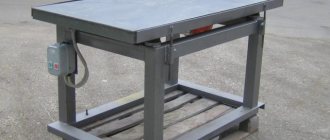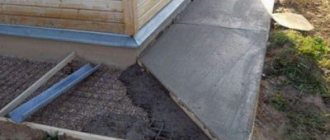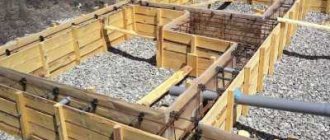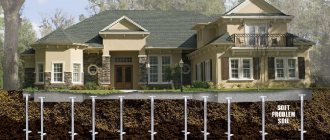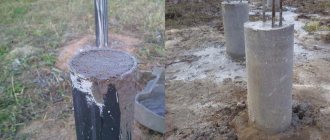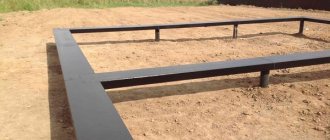Home |Technique and materials |How to make a vibrating table with your own hands?
Date: May 23, 2017
Comments: 0
When producing concrete products, paving slabs, as well as products made from gypsum and special mixtures, it becomes necessary to compact the solution, which contains air bubbles. The vibration effect promotes uniform distribution of the solution over the form, improves the structure of the material, and increases its strength. In industrial conditions, massive and expensive equipment is used for this. It is advisable to make a vibrating table with your own hands when producing products in domestic conditions.
Instructions for making vibrating tables
If you are not ready to spend money on a unit that will be useful to you once, but you have a high desire to save money on purchasing paving slabs, you should try to make a vibrating table with your own hands. What is needed to make a vibrating table with your own hands:
- drawing;
- four steel pipes;
- corner (channel);
- metal sheet for making countertops;
- grinder or electric scissors for working with metal elements;
- a 220 V vibration motor of the required power and four bolts to secure it;
- welding machine;
- drill.
If you have everything you need, you can start making a vibrating table with your own hands.
- The optimal dimensions of the table base are 70 cm x 70 cm, however, every master has the right to make a table of sizes that suit his needs. The larger the production volume, the correspondingly wider the vibrating surface of the table and the more powerful the engine should be. The base can be easily made from a metal corner (50x50 mm is sufficient) or a channel. Its individual elements can be connected using electric welding or bolts. In the latter case, the structure will be collapsible. This is convenient if you are going to move it from one object to another. However, the bolts tend to loosen, so the rigidity of the structure will decrease.
- Legs made of steel pipes must be attached to the finished base. To make the unit stable, metal plates are either welded to them, or they are buried in the ground and filled with cement mortar. The first option is used if a mobile structure is required. In the second case, the table will be stationary.
When making legs, you need to consider three points:
- the vibration motor must not touch the ground;
- the height of the legs should be such that it is convenient for the master to work without bending;
- all 4 legs must be strictly the same size, otherwise the tabletop will be located at an angle and the concrete mixture will flow out when vibrating.
Once you've prepared the base, it's time to start making the tabletop. To do this, six steel springs must be secured to each corner, as well as to the center of the base. You can buy them at the car market. Springs from a moped, cut into two parts, are perfect for making a vibrating table. Springs from shock absorbers or car engine valves are also suitable.
A sheet of steel with sides, to which a vibration motor is attached below, is often used as a working vibrating surface. The place where it should be fixed is marked on the drawing. Forms are placed on the countertop into which concrete is poured. Another option for working surface design is a steel frame with a sheet of OSB, chipboard or plywood inside.
You can connect the tabletop and the frame in different ways:
- weld the spring with one end to the working surface and the other to the base (one-piece connection);
- fix one end of the spring to the tabletop by electric welding, and insert the other into a glass with a height equal to a third of the spring, mounted on the frame;
- You can swap the places where the spring is attached and the location of the cups.
The vibration motor is fixed motionless on the tabletop. If you use models IV-98 or IV-99, the vibration will be very strong. The working surface in this case must be made of steel sheet with a thickness of at least 10 mm or be weighted (concrete ballasts).
This is not required if you take an ordinary electric motor and install a homemade eccentric on it instead of a pulley. However, you can cut off individual parts of it or drill several holes in it, thus unbalancing it.
The vibration motor can be positioned in three ways:
- in the horizontal plane (the vibration will then be horizontal);
- in the vertical plane (with horizontal vibrations);
- at an angle of 45 degrees to the tabletop (to obtain vibration in all planes).
As you can see, the design is simple and making a vibration table with your own hands is quite possible. There would be a desire.
Purpose of the product
The vibration platform, which is easy to make with your own hands, makes up to 3000 vibrations in 60 seconds and is intended for the following purposes:
- production of small-scale products using vibration casting;
- production of tiles for sidewalks;
- compacting products made from cement and asphalt concrete mixtures;
- molding blocks from foamed concrete;
- vibration compaction of fence elements, decorative items, window sills;
- carrying out various types of product testing.
Homemade options
You can make different vibrating table designs with your own hands. Let's consider possible options for homemade production.
Unmolding design
Such a vibrating table is needed to remove dried tiles from the mold. The design of the vibrating table is not particularly different from the standard one. The only difference is that a hole is made in the upper part.
Work is carried out in two ways:
- An additional tabletop is being prepared. If the springs are not welded on top, then replacement is simple.
- The original table top is being refinished. To do this, a removable hatch is made on one side. A soft base is placed below where the tiles fall.
Non-standard devices
Making a vibrating table with your own hands is quite labor-intensive. If there is a need for a small volume of paving slabs, then a simplified design is used. Work on it can be performed at a high level.
These types of tables include the following designs:
- From tires. Depending on the required height, 2 or 3 tires are taken. A wooden shield rests on top of them. Wooden sides are made on the sides so that the forms do not move. You can attach the shield to the top tire with screws. A form with a solution is placed on a wooden surface. Tapping the wood with a rubber mallet begins to create vibration. It is allowed to mount a motor with an eccentric in the lower part of the wooden panel.
- From an impact drill or hammer drill. To do this, a metal plate is attached to one end of the wooden plane, and rags or rubber are nailed to the other. The soft part rests against the wall. A perforator is connected to the metal plate. Instead of a drill, a pipe is inserted into it. Its thickness should be such that it is possible to freely enter the cartridge. When you turn on the hammer drill, a good vibration begins.
If you have a summer cottage, the need for a vibrating table arises constantly. The purchased product is expensive. By making the structure yourself, there is a significant saving of financial resources. There is not always a need for serious adaptation. In this case, you can get by with simplified designs. There are always old tires or a rubber hammer in the household. The product is small, but the work is done efficiently.
The simplest design
Making a vibrating table is not practical if you need to make several cinder blocks or slabs. You can compact the building mixture in a mold using a simple design. For this:
- Spring elements are attached to the surface. These are rubber cushions, springs, car tires, etc.
- A shield made of wood or metal is placed on top.
- Place forms with building mixture.
- Create oscillatory movements of the shield. To do this, tap the surface with a hammer. The intensity of oscillatory movements is increased with a drill in hammer drill mode. The chuck of a power tool rests against a shield to transmit vibration.
This way it is possible to make the contents of the mold sufficiently dense without using a vibrating table with an electric motor.
Step-by-step instructions for making a vibrating table with horizontal vibration
The first thing you should pay attention to before starting work is the size of the countertop. It is believed that the minimum surface size should be 600x600, since with narrower sides, the forms will fall during movement
In addition, a narrow structure will have less stability.
In many ways, the size of the vibrating table is determined by the required production volume. We can say that there is a direct relationship here - the more elements must be made at a time, the larger the countertop area should be. Naturally, a large concrete block press will require a more powerful engine, and the materials from which the structure will be assembled must be very durable.
Vibrating table base and unbalance mounting
As for the height of the vibrating table, it all depends on the individual data of the person who will work at it. The standard height, optimally suitable for a person of average height, is 90-100 cm.
Materials and tools required to assemble a vibrating table: prices and characteristics
In order to assemble the structure yourself, you will need a grinder, a welding machine, a drill, as well as the ability to handle them. Let's look at the list of necessary materials that can easily be found among handheld materials.
An example of the implementation of a vibrating table for the production of paving slabs with a molding attachment
For the countertop, you can use plywood or a sheet of metal of a suitable size. In this case, the plywood sheet should be 14 mm thick. This will allow more vibration to be transmitted due to the small thickness, but at the same time provide the necessary structural strength. In addition, in this way you can significantly reduce the noise level during operation of the device. If a metal sheet is used, then its thickness should be within 5-10 mm.
The cost of a sheet of plywood of the required thickness, made from birch veneer, will be about 650 rubles with a standard size of 1525 × 1525 mm. But a sheet of hot-rolled metal 5 mm thick will cost more, about 1000 rubles.
Weights are used to excite vibrations in the vibration mechanism of the vibrating table
Metal corners measuring 50x50 mm. They will be required to create the edging of the tabletop and during the operation of the vibrating table will not allow the molds for the production of paving slabs to move from the surface as a result of vibration. Their cost will be about 140 rubles per 1 m.p.
Channel for mounting the motor (about 210 rubles/m.p.). It will need to be welded to the center of the back of the tabletop, pre-drilling holes that will be used for the bolts that hold the motor.
Metal pipes for table legs. Typically, elements with a thickness of 2 mm and a size of 40x40 are used for this purpose. The price will be 107 rubles per 1 m.p.
The reliability of the fastenings of all elements of the vibrating table ensures the correct operation of the device, the quality of the manufactured products and the long service life
Pipes for forming the upper and lower parts of the frame. Since the main load will fall on these elements, it is worth choosing a fairly durable material - 40x20 and 2 mm thick for the upper part and at least 20x20 of the same thickness for the bottom. The cost will be 84 rubles/m.p. and 53 rub/m.p. respectively.
Metal plates that will be used as a sole for supporting legs. For this purpose, pieces of metal measuring at least 50×50 and 2 mm thick are suitable.
You will also need a plate for installing electrical equipment and springs, which are designed to provide vibration. It is quite possible to purchase these elements at a dismantling station. Numerous reviews indicate that the ideal option is to use springs from mopeds, the cost of which with a height of 113 mm and a diameter of 54 mm will be about 500 rubles. They are installed in the corners of the table, and if the surface area is large, another one is additionally mounted in the center.
A vibrating table for making paving slabs can be made from scrap materials without significant financial investment.
Do you need to bother?
What kind of vibrating table do you use?
HomemadePurchased
If the manufacturing process seemed too complicated to you, let's touch on the issue of productivity and payback. A regular vibrating table allows you to make up to 60 square meters of tiles per day. This is enough not only for the construction of a private parking lot, but also for the production of paving slabs for sale.
If you do not shake the concrete, the tiles will become fragile and such products are not suitable for sale. If you buy an assembled device, it will be expensive and the return on investment will be lower.
Manufacturing and installation of a vibrating platform
The upper surface of the vibrating table must be made of a flat sheet. Rigidity is imparted to the structure by making the sheathing from a profile pipe, angle, channel, etc.
The rigidity of the tabletop is necessary to eliminate high noise levels during use.
It is recommended to make a border around the perimeter of the tabletop. Its height is 30-60 mm and is selected separately. A corner is used to make the side. It is attached to the tabletop by welding or threaded connections.
In the center of the table top lathing, a bracket is made for mounting the electric motor. At the same time, the quality of the welds is monitored. The joints between the unit and the sheathing are subject to high loads. Poor quality welds will lead to failure of the compacting equipment.
The vibration platform is mounted on movable pads with the engine facing down. The springs are attached to the tabletop. When installing the vibrating platform, make sure that the surface is positioned correctly in the horizontal plane.
After connecting the table parts, the power wires of the unit are attached. To avoid breakage due to vibration, the wiring is fixed to the structure with clamps. In this case, the wire is located with sagging between the upper and lower parts of the product. The presence of a loop compensates for vibrations in the upper part. The starting device and control buttons are placed in a box.
Motor selection
The power of the unit is selected based on the size of the table. Single-phase asynchronous motors with an operating voltage of 220 V are suitable for home use.
In some cases, electric motors from used household appliances are used to make a vibrating table.
To increase functionality, the engine control unit is equipped with a speed controller. This is how the intensity of vibrations is changed for different building mixtures.
When choosing an electric motor, pay attention to the reliability of the rotor bearings. When the table is in operation, there is a load on the bearings. Under the influence of vibration, the seats wear out.
Vibrating table manufacturing technology
On the Internet you can find many different technologies for making a vibrating table. Before carrying out the actual work, you should consider: 1. The most durable method of connecting individual elements is the use of rivets. They can withstand vibration without deformation or destruction. 2. In 99% of cases, welding is used, because it can withstand high loads. 3. The height of the structure is selected depending on the height of the master and other factors.
Working with rivets requires a special tool; welding machines are more common, but their use requires special skills.
bed
The design of the machine in question is mounted on a frame. To produce it, an angle grinder with an appropriate attachment is required. Assembly is carried out as follows: 1. 2 frames from the corners are welded. 2. 4 racks are welded to the frames.
If there are no corners, then any assortment can be used. An example is the use of a round pipe as a spring guide.
Vibration platform
The working surface is represented by a vibrating platform. It is made in the form of a removable element. For production you need: 1. Sheet with a thickness of 2.5 mm or more. It is expensive, but can last for a long period. 2. It is possible to use chipboard. This budget option can be quickly replaced if necessary.
The tabletop frame is strengthened in the central part. The motor used is installed at the bottom of the structure. The top plate is fixed by springs, which are located around the entire perimeter.
Vibration motor
A special table for making paving slabs cannot be assembled without the main unit, which is the engine. There are a large number of different models on sale; you will have to independently assemble an eccentric unit for them. It is created taking into account the engine power and its size.
Factory vibrator
In some cases, the machine in question can be upgraded into a circular saw. To enable such modernization, an EV-98E vibrator is installed. Its features are as follows: 1. There is amplitude adjustment. 2. Powered by 220 V. 3. The main difficulty lies in adjusting the electric drive.
The industrial device can last for a long period. In addition, it has higher performance characteristics.
Homemade vibration drive
A vibration drive in a simplified form is represented by a curved piece of reinforcement in a vice, which is placed in an electric drill. At the moment of switching on, a piece of reinforcement provides an imbalance, due to which the required vibration occurs. However, this option is not suitable for long-term use, because the drill will not last long. Therefore, the following design is being created: 1. 1 or 2 eccentric type plates are put on the shaft. 2. The amplitude can be adjusted if necessary.
Such a drive can last much longer
When assembling, you should pay attention to the reliability of fastening the pancakes, because the resulting load can cause them to shift
DIY vibration table
How to make a table for molding small and medium-sized concrete products? What material is needed for this? In this article you will find answers to these and other questions. The text contains full video tutorials on assembling a vibration table with your own hands with a detailed description of the work progress.
A vibrating table is a device for vibrating liquid solutions placed in molds. This could be paving slabs, sections of a “Euro fence”, artificial finishing stone. In this article we will look at options for making a vibrating table with your own hands.
How does a vibrating table work?
The principle of operation is extremely simple - vibrations are transmitted from the activator (vibration motor) to the plane - in this case, to the table top. The vibrations are then dampened by shock-absorbing pads or springs. On the table top there are objects or forms with a liquid solution that requires vibration.
Materials and tools
To create the design we will need the following tools:
- welding machine;
- grinder with a metal disc;
- mechanic's hand tools;
and materials:
- corner 40x40x2 - 6 meters;
- rectangular pipe with a cross-section of 40x20 - 6 meters;
- sheet of metal or laminated plywood 120x750x3 - 1 pc.;
- springs (from Kamaz timing belt), analogue or rubber struts - 4 pcs.;
- asynchronous motor 220 V/1500 W - 1 pc.;
- bolts/nuts, improvised material.
Assembling a vibration table with your own hands
The finished tool will have dimensions:
- cover - 120x750 mm
- table height - 850 mm
As preparation, the material should be cleaned of rust and a working area should be prepared.
Manufacturing a fixed frame
The table frame or bed is the supporting part of the entire machine
By and large, it doesn’t matter what it’s made of (just not wood!), since its task is to hold still the vibration damping points (springs or rubber pads) on which the lid rests
Theoretically, this could even be a concrete slab or foundation section.
Progress:
- Cut legs from a corner - 4 pcs. 750 mm each.
- We cut a stationary frame from professional pipe 20x40 - 2 pcs. 600 mm each and 2 pcs. 1 m each.
- Weld the frame and weld the legs vertically at the corners.
- Weld springs onto the upper plane of the corners.
Making the lid
The table cover will not be rigidly tied to the frame - it will simply stand on springs. The sides of the “glasses” made from the pipe will prevent it from falling off during operation. Instead, you can use any analogues, for example, rubber parts of old factory machines. These elements are extremely durable and will last for many years.
Progress:
- Cut the corrugated pipe - 2 pcs. 600 mm each and 2 pcs. 1 m each.
- We weld the frame similarly to the stationary one (mirrored), but with two additional transverse ribs.
- On the ribs we arrange a platform for mounting the vibration motor with holes in place.
- At the corners of the movable frame of the lid we weld rings of a steel pipe Ø 50 mm and height 30 mm.
- We weld a sheet of metal onto the ribs.
Making a vibration motor
Vibration activation in our case will be carried out from an electric motor. To make it appear, we unbalance the motor shaft by adding an eccentric to it. The easiest and fastest way is to weld bolts Ø 12–14 mm onto the shaft and weight them with nuts. The loads should be placed on both sides, parallel to each other - this way the maximum vibration force is achieved.
The weight of the load depends on the power of the motor, which in turn depends on the size of the table. These three indicators are interrelated and the mass of cargo is a dependent parameter.
Most often, such products are assembled from scrap materials, and there is not always a choice. A primitive calculation of motor power is 1500 W per 1 m2 of table top area.
The optimal mass of weights is selected experimentally - nuts are screwed onto the bolts. By moving the nuts along the bolt threads, you can adjust the vibration amplitude.
Putting all the parts together
Install the engine onto the seats using bolts. It is recommended to install a circuit breaker on each power cord. Since the cover together with the motor has significant weight, it is quite easy to install it with “glasses” on the springs.
Attention! After installation at the work site, be sure to ground the table. The design can be painted and modified based on local conditions and machine operating requirements
Before starting, make sure that the frame is securely supported, otherwise the device may tip over.
The design can be painted and modified based on local conditions and machine operating requirements. Before starting, make sure that the frame is securely supported, otherwise the device may tip over.
The vibrating table of the described design is suitable for private households - the production of concrete elements for their own needs. The engine itself can also be used on a homemade vibrating plate or vibrating screed during concrete work.
Step-by-step instructions for making a vibrating table with your own hands
The project is selected based on the required dimensions. The more impressive the dimensions of the plate, the more molds will fit on it, but its weight increases, and accordingly, a more powerful drive is required. Typically the length is approximately 1800-2000 mm and the width is 750-800 mm. The engine power is selected taking into account the total mass of the tabletop, molds and concrete mortar (for every 100 kg of weight - 1 kW). A typical drawing assumes that the vibration unit will be located under the slab, in the center.
In addition to the electric motor, the following materials are prepared:
- 4 support posts (legs) made of rolled steel from an angle, I-beam or rectangular pipe, each length is 800 m.
- Corner for a frame with a section of 25x25 or 40x40. The total length is calculated according to the drawing (about 10 m).
- Carbon steel sheet with a thickness of 3-12 mm for the manufacture of tabletops.
- Shock absorbers are durable, heat-treated spiral springs, the number of which, as well as the arrangement, is determined according to the project.
- Steel sockets (cups) for springs.
Springs from ZIL truck valves are used as shock absorbers, and pipe sections serve as sockets.
Manufacturing technology:
1. Frame. The corners cut to the size of the drawing are welded. To give the structure rigidity, the legs are connected to each other by crossbars, and to the upper rectangular frame using inclined struts.
2. Glasses are welded to the upper ends of the supports or frame: if their height exceeds 2 cm, then the springs are placed in them without fixation. In other cases, bolted connections are used. A rigid scheme for fastening the springs to the table (welding) is not justified. First, the shock absorbers will be difficult to replace. Secondly, the ability to horizontally adjust the tabletop is lost.
3. Glasses are also welded to the top plate in appropriate places and placed on top of the springs.
4. Brackets are welded in the center of the subframe and the electric motor is attached to them. Its shaft should be oriented along the table.
5. An eccentric is fixed on the shaft shank. Its role can be played by a flange with drilled holes for securing weights.
Each weight is selected through experiment depending on the rotation speed and motor power. The weight of the weights should not be excessive, otherwise the engine will fail. To prevent the eccentric from becoming detached from the shaft during operation, the rotating part of the motor is protected by a protective casing.
Recommendations
The drive of the device does not require much power, so home craftsmen often assemble a vibrating table with a motor from a washing machine. The service life of such an engine is short, but under moderate load its resource will last for several years. Experts advise immediately modernizing the motor: instead of bushings, install reinforced bearings. If a vibrating table will be used in the production of tiles for sale, it makes sense to buy ready-made vibration motors IV-98 or IV-99, designed for 220V. They have a large power reserve, the speed is adjusted depending on the size of the molds.
Craftsmen who have made their own vibration devices sometimes complain that in the center the table vibrates less, and at the edges the forms bounce and move apart. To avoid such problems, it is advisable to find well-written drawings that indicate the optimal dimensions of materials. The mass of the work plate is calculated in such a way as to correspond to the capabilities of the electric motor.
A few practical tips from experienced specialists will help you achieve uniform vibration.
- The operating scheme of the equipment should ensure that the vibration amplitude is not too large, so that the concrete is gradually distributed among the forms and does not bounce off the walls. The oscillation frequency is selected experimentally, comparing the quality of the resulting products.
- An accurate dosage of the concrete mixture is needed - this will not only stabilize vibration, but will also help avoid molding tiles of different heights.
- The table is installed strictly horizontally, without distortions.
For additional stability of the structure, round plates cut from sheets are welded to the lower ends of the supports. If powerful vibration causes the table to move, the “nickels” can simply be concreted, but it is better to drill holes in them to connect the table to the base with anchor bolts.
When making a vibrating table on their own, sometimes they decide to make the slab or the entire frame from wood. This is a big mistake: wood dries out over time. For this reason, the geometry is completely disrupted, alignment is lost, the required amplitude is not achieved, and the quality of the tile decreases.
Vibrating table
A vibrating table for making paving slabs is a metal structure similar to a regular table. The upper part must be secured with cups or springs, forming a gap. With the help of a motor, which is mounted in the lower part, the table begins to vibrate.
Vibrating table design
Based on this, the solution, which is in the mold, is distributed over the area in equal quantities and displaces air. If you make paving slabs without a table, then their quality will be quite low. Subsequently, it will not last long. If air remains in the tile, it gradually begins to destroy it.
Vibrating table made from tires
An almost ready-made solution for a vibrating table frame is used tires from a car. They are connected in height with self-tapping screws through and through, the vibrator is attached to the bottom of the removable vibration platform, located inside the tire, preventing the tabletop from falling.
Vibrating table made from tires.
If paving stones are needed in small quantities, the platform can be made of laminated or bakelite plywood, OSB/chipboard. For paving large areas, you will have to use sheet metal with a thickness of 3 mm or more. The vibrator is attached to the platform according to the drawing with bolts all the way through.
Vibration motor mount.
The bolt heads on the front side of the platform are hidden in blind holes that can be filled with a polymer or epoxy compound. The power cable can be routed under the tires or through a hole in the tread of any of them.
For small volumes of vibration casting of FEM shaped paving elements, another technology can be used:
- a workbench tabletop with household equipment in use (for example, a sharpening machine) is installed on the tire;
- fixation of spatial geometry is carried out by pegs/pipes driven into the ground;
- the sharpening machine is fenced off from the working area with a block so that random mortar/concrete does not fall on it.
Vibrating table from a grinding machine.
This will allow you to cast a curb, several paving slabs and storm drainage elements in a short time.
The vibrating table can be equipped with an additional option for sifting sand, which is necessary after making paving slabs before paving individual areas of the site. To do this, it is enough to cover the electric drive with a casing made of sheet material, arrange a funnel from galvanized or dense fabric at the bottom, and replace the vibrating platform with a mesh.
Additional function of sifting sand with a vibrating table.
Thus, from the considered options, you can choose the optimal design for specific conditions. For example, a collapsible vibrating table will allow the use of individual elements and assemblies at the next stages of landscaping and operation of the site.
Good publicity
Most read
Principle of operation
A universal unit that facilitates the molding process functions as follows:
- the base of the vibrating table frame is rigidly attached to the floor surface;
- the power cable is connected;
A correctly set vibration amplitude guarantees uniform distribution of the solution over the vibroform and its gradual hardening
- a form filled with solution is installed on the working platform;
- the vibration motor is turned on by pressing the corresponding button on the remote control;
- a process of intensive compaction is carried out, as a result of which air bubbles come out of the solution and the mixture settles, becoming more dense;
- the supply of electrical energy is turned off;
- containers with molded products are removed from the horizontal plate;
- the next cycle of vibration compaction occurs according to the given algorithm.
A self-made vibrating table and an industrial unit work on the same principle.
Engine on vibration table and drawings
The engine power should not be too high, which is why many people use motors from washing machines. Its only drawback is its small resource. But if there are no plans to provide tiles to the entire area, then one engine can work properly for several years under average loads. The motor can be modified, since its main weak point is the bushings or bearings. If you immediately change the bearings to reinforced ones and remove the bushings and replace them with bearings, the table will last even longer.
You can use a ready-made vibrator. IV99, for example, will cost 5-7 thousand, but it is practically eternal, since it has a power reserve and is designed for such work. An excellent addition would be a speed controller. With this, you can adjust the vibration frequency for each batch of tiles separately.
Rating of popular factory models
If you don’t have time for assembly, and factory quality and warranty come first, buy one of the popular models of vibrating tables. The average price of vibrating tables on Yandex Market is 20-25 thousand rubles. Small specimens are sold for 6-8 thousand, but their productivity is low, and they are designed for working with plaster.
VO-100 220V 220V
Dimensions: 1000x700x800 mm.
Weight: 155 kg.
Price: 27 755.
VO-60 220V 220V
Dimensions: 600x600x700 mm.
Weight: 105 kg.
Price: 21 475.
VO-50 42/380 V 42/380 V
Dimensions: 500x500x600 mm.
Weight: 90 kg.
Price: 18 576.
VS-180 42/380V 42/380V
Dimensions: 1000x500x800 mm.
Weight: 140 kg.
Price: 25 679.
VS-950 42/380V
Dimensions: 2000x1500x800 mm.
Weight: 600 kg.
Price: 79 769.
EV-342 3-380V
Dimensions: 980x480 mm.
Weight: 180 kg.
Price: 57 100.
